Change improves existing structures, while transformation creates new possibilities with a radical shift in form or mindset, reshaping perspectives.
Did you know that change and transformation are not the same thing, despite being used interchangeably in many contexts? Understanding the difference between these two concepts is crucial in unlocking personal and organizational growth. While change involves making alterations or improvements to something that already exists, transformation goes beyond that and entails a thorough or dramatic shift in form or appearance. In this article, we will delve into the definitions, processes, and impacts of change and transformation, providing you with valuable insights to navigate the ever-changing landscape of growth and development.
Key Takeaways:
- Change and transformation are distinct concepts, with change focusing on improvements to existing structures and transformation involving a fundamental shift in form or appearance.
- Change is a step-by-step process aimed at reaching a desired state, while transformation requires a profound shift in thinking and approach.
- Nokia’s downfall serves as a stark example of the importance of embracing transformation in the face of disruptive technological advancements.
- Building transformative capability advantages involves cultivating a transformative mindset and developing the necessary skills and resources to thrive in a rapidly changing environment.
- Developmental growth and transformation are both essential for personal and professional development, with the former focusing on acquiring new skills and perspectives and the latter involving a radical shift in form or mindset.
Understanding Change
Change is a process that aims to produce a better version or improvement of a current state. It involves making modifications, adjustments, or adaptations to existing structures, systems, or processes. Examples of change include:
- Implementing new technology
- Restructuring organizational departments
- Improving operational efficiency
The change process typically follows a step-by-step approach. It begins by identifying the current state (State A) and then planning and implementing actions to reach the desired state (State B). This systematic approach ensures a clear understanding of the change objectives and helps to monitor progress along the way.
Embracing Transformation
Transformation is more than just making things better; it’s about creating entirely new and innovative ways of doing things. Unlike change, which is a step-by-step process, transformation involves big shifts in how we think and act. For instance, the rise of smartphones completely changed how we live and work, showing how transformation can revolutionize industries. Companies like Uber and Airbnb also shake up traditional ways of doing business, proving that embracing new ideas can lead to success.
To embrace transformation, you need to be open to new ideas and willing to challenge old ways of thinking. It’s about trying new things, even if they seem different or risky. Transformation isn’t a straightforward journey; it’s full of twists and turns. But by being open to change, you can unlock new opportunities and achieve remarkable growth and success.
Contrasting Change and Transformation
The table below highlights the key differences between change and transformation:
| Change | Transformation | |
|---|---|---|
| Definition | Refers to making alterations or improvements to something that already exists | Involves a thorough or dramatic shift in form or appearance |
| Focus | Improving existing structures, systems, or processes | Creating a completely new and innovative future state |
| Approach | Step-by-step process | Non-linear and requires a profound shift in thinking |
| Examples | Implementing new technology, restructuring organizational departments, improving operational efficiency | Introduction of groundbreaking technology, disruption of established industries, emergence of new market advantages |
The Impact of Transformation: Nokia’s Story

Nokia’s downfall underscores the importance of transformation. Once valued at $250 billion, Nokia failed to grasp the potential of smartphones, focusing solely on hardware improvements. In contrast, Apple’s introduction of the iPhone in 2007 revolutionized the market, highlighting the power of transformative innovation.
Nokia’s reluctance to embrace change and its attachment to past success led to missed opportunities and the eventual sale of its phone business. This cautionary tale emphasizes the necessity for companies to challenge norms, innovate, and envision new possibilities to remain competitive in today’s dynamic market.
| Nokia’s Downfall | Lessons Learned |
|---|---|
| Lack of foresight regarding the importance of software in smartphones | Recognize the transformative power of technology and anticipate future trends |
| Failure to adapt and embrace change | Embrace transformation as a necessary step for growth and success |
| Reluctance to let go of past success | Continuously innovate and evolve to stay ahead of the competition |
The Process of Transformation

Transformation is a powerful process that helps individuals and organizations adapt and succeed in a changing world. It’s about understanding that the choices we make now shape our future. By being open to new ideas and questioning old ways of thinking, leaders can drive innovation and unlock their full potential.
To embrace transformation, organizations must first identify what’s holding them back. This means looking critically at how things are done and encouraging diverse perspectives. Building transformative capability involves investing in technology, training employees, and fostering collaboration. By doing this, organizations can thrive in an ever-changing environment and seize new opportunities for growth.
Building Transformative Capability Advantages – Key Strategies
- Investing in technology and infrastructure to enable flexibility and agility.
- Developing and empowering employees through training and professional development programs.
- Fostering a culture of innovation and creativity that encourages experimentation and risk-taking.
- Building strategic partnerships and collaborations to access diverse perspectives and leverage external expertise.
- Emphasizing continuous learning and improvement to ensure ongoing adaptation and evolution.
By implementing these strategies, organizations can build transformative capability advantages that set them apart from their competitors. They become better prepared to respond to change, embrace opportunities, and drive sustainable growth and success.
| Change | Transformation |
|---|---|
| Improvements to existing systems or processes | Radical shift in form or appearance |
| Linear process | Non-linear process |
| Incremental progress | Dramatic and fundamental change |
| Focuses on the current state | Focuses on creating a new future state |
Business Transformation vs Change Management
Business transformation and change management are crucial for organizational success, but they serve different purposes. Business transformation focuses on making big changes to an organization’s strategy, operations, or technology to improve its overall competitiveness. It’s like giving the organization a new direction to follow, unlocking new opportunities, and staying ahead in a fast-changing market.
On the other hand, change management is about guiding the process of implementing those changes within the organization. It involves planning, communicating, and executing the changes effectively to achieve the desired outcomes. While business transformation sets the big picture, change management ensures that everyone in the organization understands and adapts to the changes smoothly. Both are important for growth, but they have different roles to play.
Below is a summarized comparison of business transformation and change management:
| Business Transformation | Change Management |
|---|---|
| Focuses on significant changes in strategy, operations, or technology | Focuses on managing the transition or implementation of a change within an organization |
| Aims to improve overall performance and competitiveness | Ensures effective execution of the change process |
| Requires a holistic and comprehensive approach | Requires a structured and tactical approach |
By understanding the differences between business transformation and change management, organizations can effectively leverage both concepts to stay competitive in today’s dynamic business landscape. Business transformation provides the vision and direction for change, while change management ensures its successful implementation.
The Importance of Developmental Growth and Transformation
Both developmental growth and transformation play integral roles in personal and professional development. These processes enable individuals to adapt, thrive, and reach their full potential in an ever-changing world. Let’s explore the significance of developmental growth and transformation and their impact on individual growth and adaptability.
Developmental Growth: Expanding Knowledge and Challenging Beliefs
Developmental growth involves discovering new opportunities, continuously expanding knowledge, and challenging existing beliefs. By embracing a mindset of openness and curiosity, individuals can actively seek out learning experiences and acquire new insights. This growth mindset allows for personal and professional development by encouraging self-reflection, acquiring new skills, and broadening perspectives.
Transformation: Reimagining the Self and the World
Transformation, on the other hand, goes beyond the acquisition of knowledge and skills. It involves a profound shift in form or appearance, leading to significant changes in how individuals perceive themselves and the world around them. Through transformation, individuals undergo a fundamental metamorphosis that can alter their beliefs, values, and goals. This transformative process allows individuals to reinvent themselves and embrace new possibilities, paving the way for personal and professional breakthroughs.
Developmental growth and transformation are interconnected processes, each contributing to the overall development of individuals:
| Developmental Growth | Transformation |
|---|---|
| Continuous expansion of knowledge and understanding | Radical shift in form or appearance |
| Challenging existing beliefs and perspectives | Profound changes in self-perception and worldview |
| Acquiring new skills and competencies | Reimagining possibilities and embracing new opportunities |
By actively engaging in both developmental growth and transformation, individuals enhance their adaptability and capacity for personal and professional success in a rapidly evolving world. These processes enable individuals to navigate change, embrace innovation, and create meaningful impact.
The Distinction between Development and Transformation
When it comes to personal and professional growth, understanding the distinction between development and transformation is crucial. While both processes involve change and progress, they have distinct characteristics and outcomes.

Developmental Growth
Developmental growth is a continuous process of acquiring new knowledge, expanding understanding, and challenging existing beliefs. It focuses on improving personal or professional performance by acquiring new skills, gaining different perspectives, and honing existing abilities. Developmental growth is like building a strong foundation that helps individuals adapt and succeed in their chosen paths.
Transformation
On the other hand, transformation involves a radical and dramatic change that goes beyond mere improvements or advancements. It represents a complete shift in form, appearance, or mindset, often resulting in significant personal or professional transformations. Rather than building on existing structures, transformation involves breaking free from limitations and embracing new possibilities. It requires individuals to question their fundamental beliefs and adopt a fresh perspective.
To better understand the differences between development and transformation, consider the following table comparing their key characteristics:
| Aspect | Development | Transformation |
|---|---|---|
| Type of Change | Gradual and incremental | Radical and dramatic |
| Focus | Improving existing skills and knowledge | Fundamental shift in form, appearance, or mindset |
| Outcome | Enhanced performance and growth | Profound personal or professional transformation |
| Process | Continuous and iterative | Disruptive and transformative |
| Level of Impact | Incremental improvements | Significant and far-reaching changes |
By understanding and recognizing the distinction between developmental growth and transformation, individuals can determine their goals and approaches to personal and professional development. While developmental growth offers gradual improvements and continuous learning, transformation opens the door to revolutionary change and profound personal or professional metamorphosis.
Conclusion
Understanding the difference between change and transformation is essential for both personal and organizational growth. Change involves improving existing structures or practices, while transformation creates new possibilities and fundamentally shifts perspectives. Organizations must discern between these two to drive success and adapt to a changing world.
Change aims to enhance the current state through modifications, while transformation entails a profound shift in form or appearance, requiring reimagining possibilities and generating new insights. By recognizing these differences, organizations can choose the right approach for their goals, whether it’s incremental changes or disruptive innovations, shaping their journeys effectively.
FAQ
What is the difference between change and transformation?
Change refers to making alterations or improvements to something that already exists, while transformation involves a thorough or dramatic shift in form or appearance.
What is the definition of change?
Change is a process that aims to produce a better version or improvement of a current state. It involves making modifications, adjustments, or adaptations to existing structures, systems, or processes.
What is the definition of transformation?
Transformation goes beyond making improvements to existing systems and focuses on creating a completely new and innovative future state. It involves reimagining possibilities, generating new insights, and fundamentally shifting perspectives.
Can you provide examples of change?
Examples of change include implementing new technology, restructuring organizational departments, or improving operational efficiency.
Can you provide examples of transformation?
Examples of transformation include the introduction of groundbreaking technology, the disruption of established industries, or the emergence of new market advantages.
What is the change process?
The change process typically follows a step-by-step approach, identifying the current state (State A) and planning and implementing actions to reach the desired state (State B).
What is the transformation process?
Unlike change, transformation is not a linear process and often requires a profound shift in thinking and approach. It involves reimagining possibilities, generating new insights, and fundamentally shifting perspectives.
Can you provide an example of the impact of transformation?
A notable example is the downfall of Nokia. Once valued at over 0 billion in 2000, Nokia failed to realize the transformative potential of the smartphone revolution. Apple, on the other hand, introduced the revolutionary iPhone in 2007, transforming the mobile phone market.
How can organizations build transformative capability advantages?
Organizations can build transformative capability advantages by developing the skills, resources, and organizational culture necessary to navigate and thrive in a disruptive and rapidly changing environment.
What is the difference between business transformation and change management?
Business transformation refers to significant changes in strategy, operations, or technology to improve overall performance and competitiveness. Change management, on the other hand, is the process of managing the transition or implementation of a change within an organization.
Why are developmental growth and transformation important?
Both developmental growth and transformation are essential for personal and professional development. Developmental growth involves being open to learning and new opportunities, challenging existing beliefs, and continuously expanding knowledge and understanding. Transformation, on the other hand, requires a radical shift in form or appearance, leading to profound changes in how individuals perceive themselves and the world around them.
What is the distinction between developmental growth and transformation?
Developmental growth focuses on acquiring new skills and perspectives to improve personal or professional performance, while transformation involves a radical and dramatic change that goes beyond improvements or advancements. It leads to a complete shift in form, appearance, or mindset.
Why is it important to understand the difference between change and transformation?
Understanding the difference between change and transformation is crucial in navigating personal and organizational growth. While change focuses on improving existing structures or practices, transformation involves creating new possibilities and fundamentally shifting perspectives.
Image Credits
Featured Image By – Gerd Altmann from Pixabay
Image 1 By – Gerd Altmann from Pixabay
Image 2 By – Kei Rothblack from Pixabay








